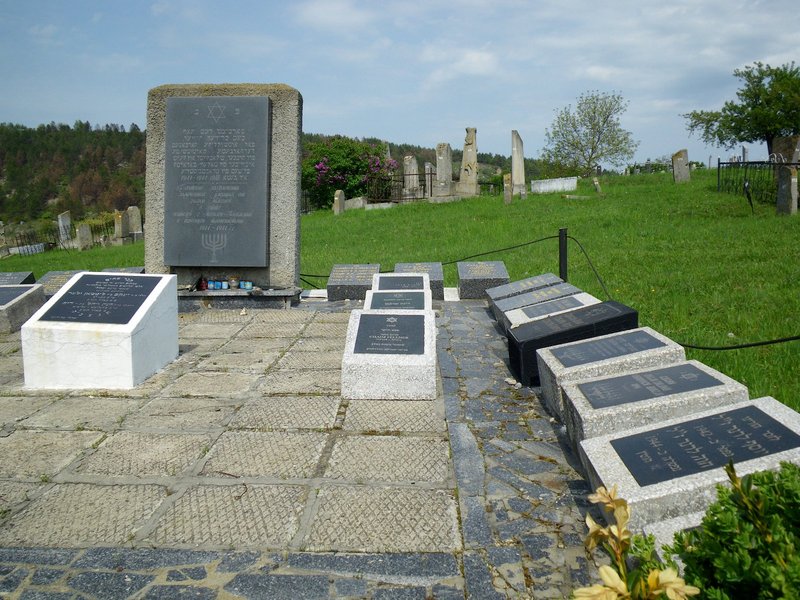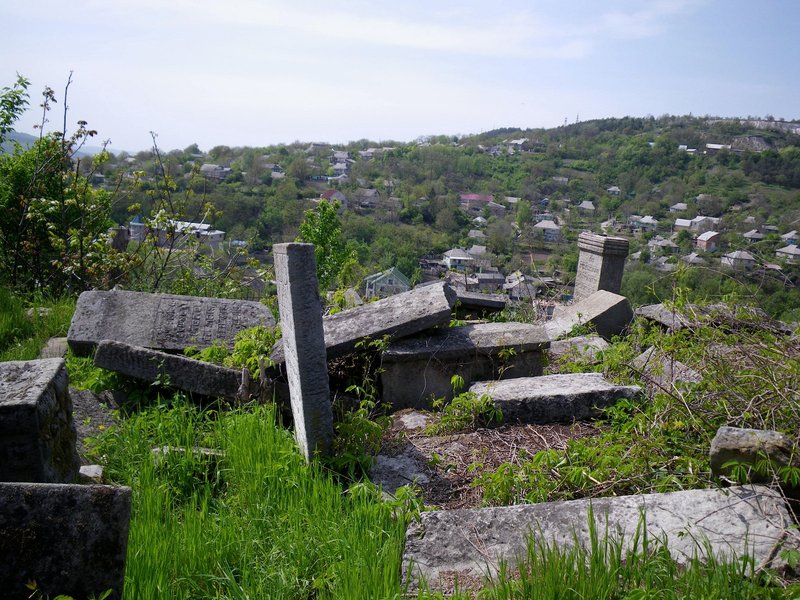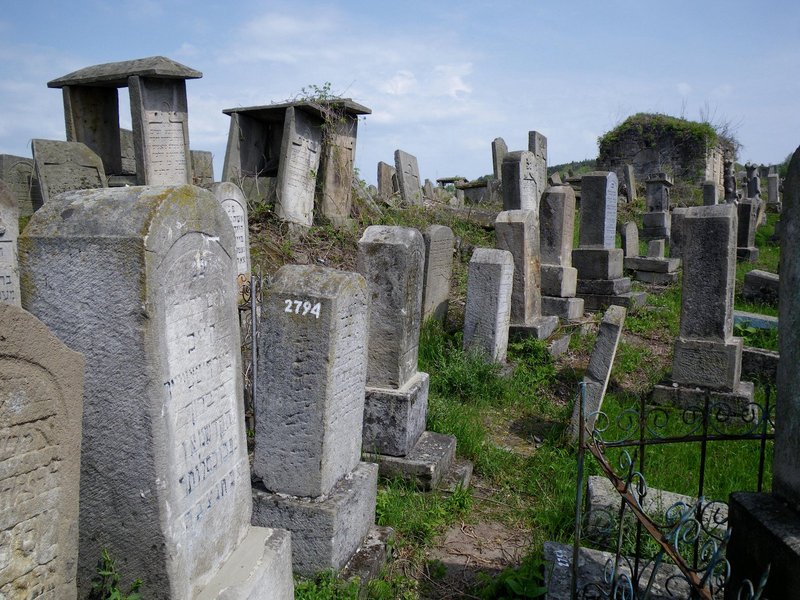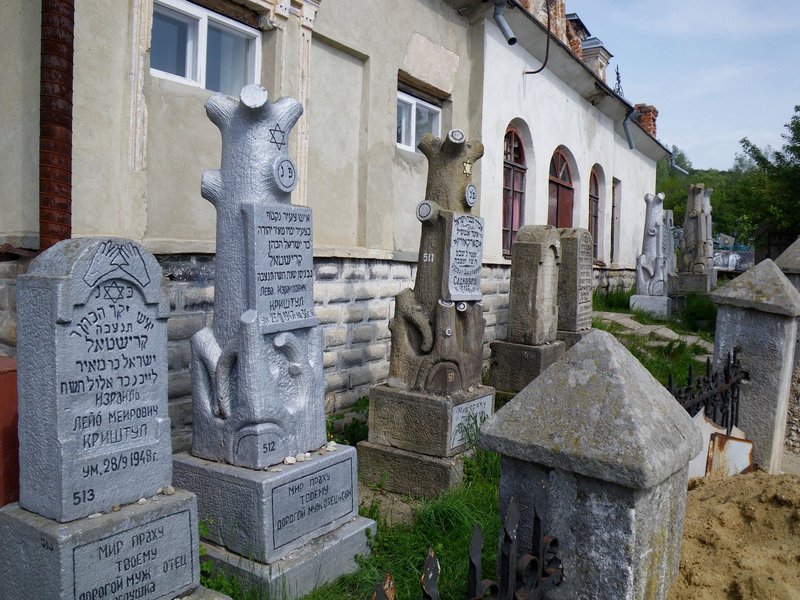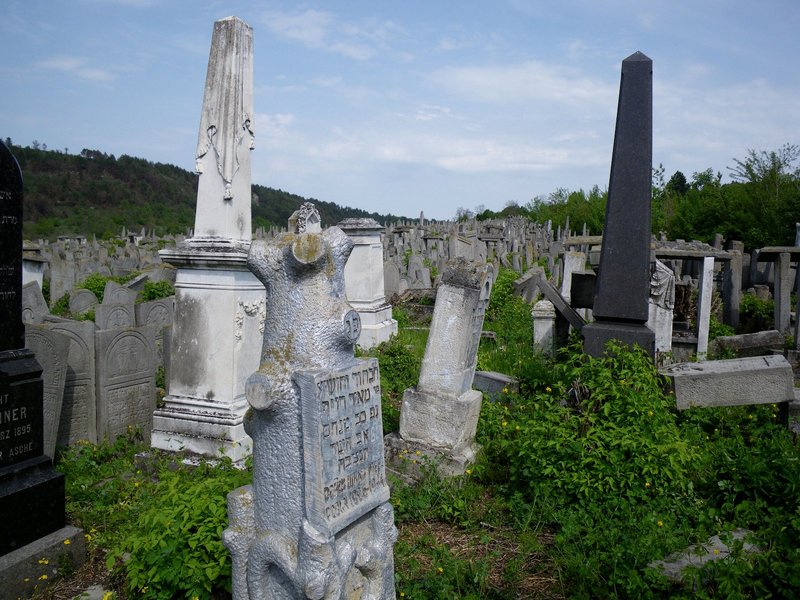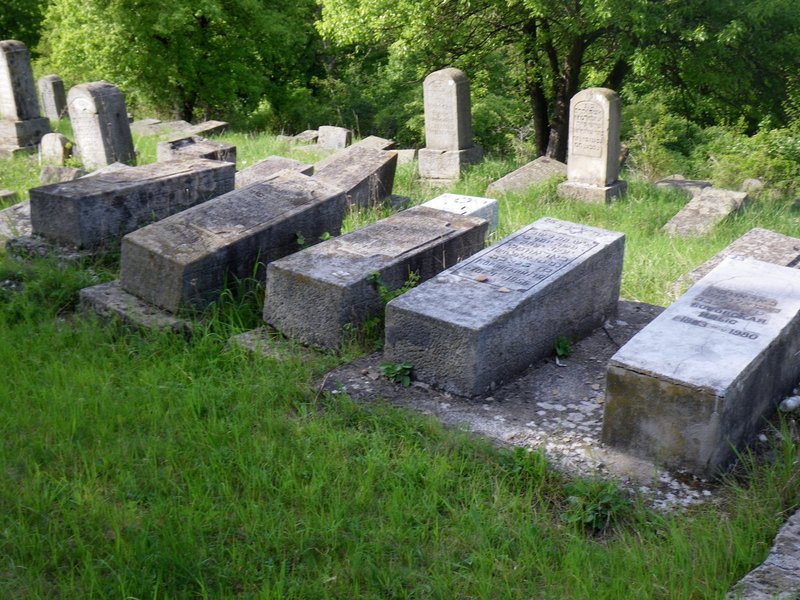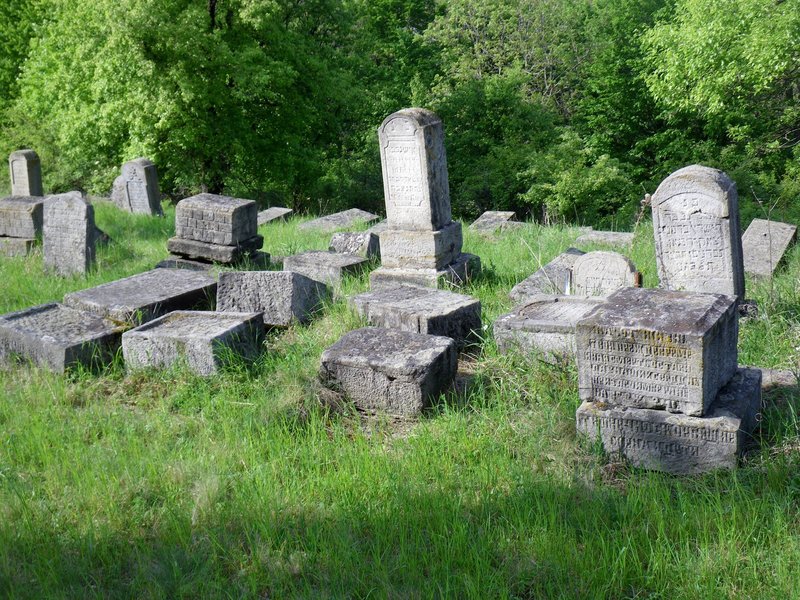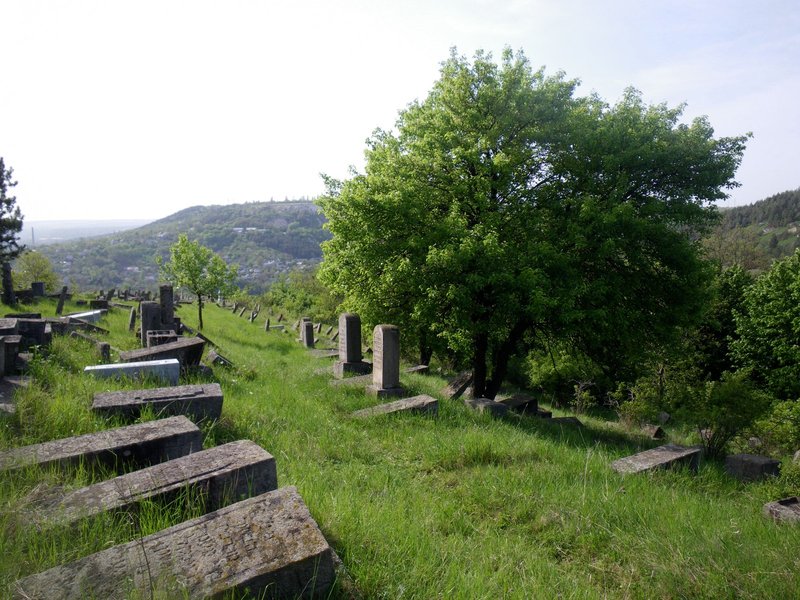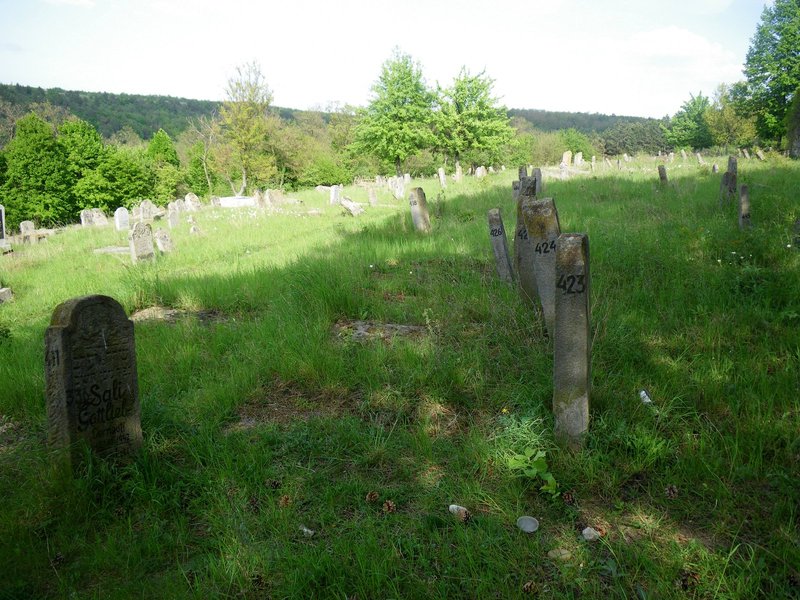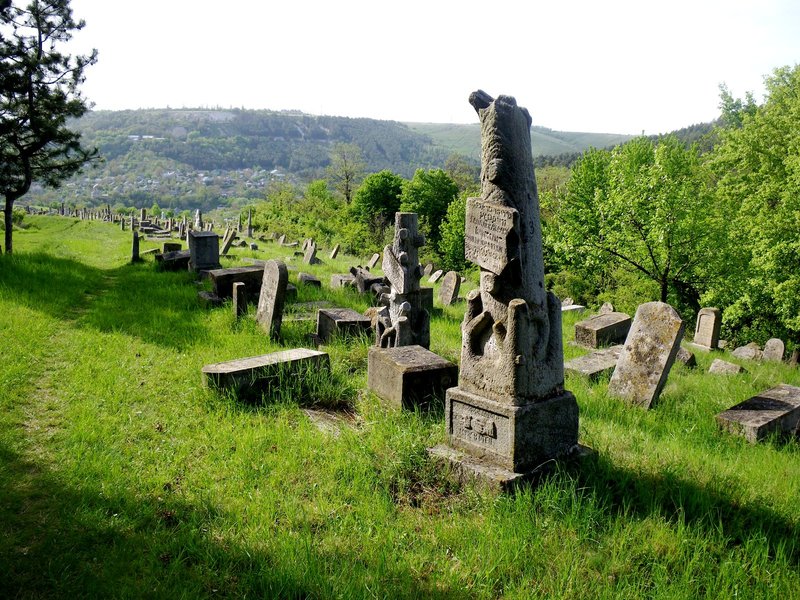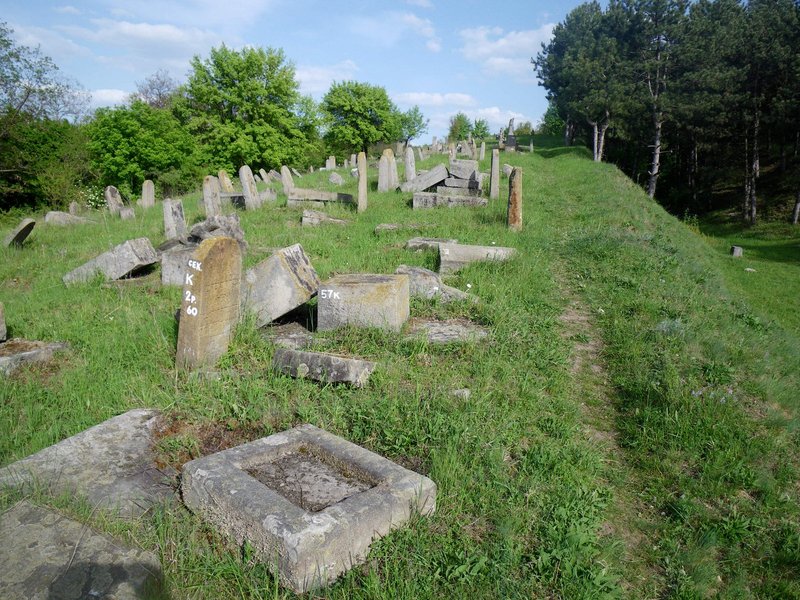Mohyliv-Podil's'kyy and Могилів-Подільський [Ukr], Mogilëv-Podol'skiy and Могилёв-Подольский [Rus], Mohilev Podolsk and מאָהילעװ [Yid], Moghilǎu [Rom], Mogilów [Pol], Mogilev, Mohylów Podolski, Mogilov Podolski, Mohyliv-Podilskyi, Mogilev-na-Dniestr is a city in the Mohyliv-Podilskyi Raion (district) of the Vinnytsia Oblast (province) at 48°27' N, 27°48' E on the border with Bessarabia and Moldova. Major city in S Ukraine, on the Dniester (border with Moldova/Bessarabia). [Not to be confused with Mogilev (Mahilyow), E Belarus.] Mohyliv-Podilskyi Raion (district) of the Vinnytsia Oblast (province) at 48°30' N 27°45' E , on the border with Bessarabia, Moldova, along the left bank of the Dniester river. On the opposite side of the river lies the Moldovan town of Otaci, and the two municipalities are connected to each other by a bridge.
ShetLink [Mar 2014]
WWII Town in the Transnistria region. Mogilev-Podolski was occupied by German and Romanian troops in July 1941 after which thousands of Jews in the town were murdered by the occupiers. Mogilev-Podolski became a transit camp for Jews expelled from Bessarabia and Bukovina to Transnistria.Before WWII, the Jewish population was 9,000. 2010 Jewish population is about 250.
- Der Geshichte der Juden in der Bukowina, vol. II
(Tel Aviv, 1962) - KehilaLinks / ShtetLink. [October 2011]
- JOWBR: Jewish Cemetery
- JewishGen-erosity Projects
(1): Mogilev-Podolskiy - Document Acquisition and Translation
- JewishGen Ukraine SIG
- Słownik Geograficzny Królestwa Polskiego (1880-1902), VI, pp. 612-616: "Mohylów".
- Shtetl Finder (1989), p. 58: "Mohilev Podolsk".
- Encyclopedia of Jewish Life (2001), pp. 480-481: "Mogilev-Podolski".
- Еврейская энциклопедия (1906-1913), "Могилев-на-Днестре".
- This email address is being protected from spambots. You need JavaScript enabled to view it.. Like Shells on a Shore. Projekt 36, Bern, Switzerland, 2010. To order, contact Mr. Geissbuhler. history and photographs. [December 2010]
"Mogilev-Podolski was occupied by German and Romanian troops in July 1941. Soon thereafter, thousands of Jews in the town were murdered by the occupiers. Mogilev-Podolski soon became a transit camp for Jews expelled from Bessarabia and Bukovina to Transnistria. From September 1941 to February 1942 more than 55,000 deportees came through the town. Thousands of people were jammed into the transit camp and treated cruelly by the Romanian guards. Many Jews were not allowed to stay in Mogilev-Podolski; thousands were forced to travel by foot to nearby villages and towns. The 15,000 who were initially permitted to stay in the town organized themselves into groups. Some 2,000-3,000 were given residence permits, while the rest lived in constant fear of being deported into the Transnistrian interior for forced labor. In December 1943 over 3,000 Jews were allowed to return to Romania, and in March 1944, Jewish leaders in Bucharest got permission to bring back 1,400 orphans. Mogilev-Podolski was liberated that month; many Jewish men were immediately drafted by the Soviet army. Many who stayed in the city were killed by German bombs. Most of the deportees were allowed to return to Romania in the spring of 1945." Source: Wikipedia. [Mar 2014]
Cemetery
|
Cemetery at Mogilev-Podolsk (Ukraine) |
||
|
Mohyliv-Podilskyi - Old Jadish Cemetery |
||
|
Mogilev-Podolski Gravestones |
http://collections.yadvashem.org/photosarchive/en-us/35832.html |
|
|
Mogilev-Podolski Synagogue 1928 |
http://collections.yadvashem.org/photosarchive/en-us/24453.html |
|
|
Mogilev Podolskiy Cemetery List |
http://boards.msn.ancestry.com/localities.eeurope.ukraine.vinnytska/16.35/mb.ashx |
|
|
Mogilev Podolsky Cemetery List |
http://boards.ancestry.com/localities.eeurope.ukraine.vinnytska/16.19/mb.ashx |
|
|
Ukraine - Cemetery Project |
http://www.iajgsjewishcemeteryproject.org/ukraine/index.html |
|
List of names of those interred in the cemetery. Contact This email address is being protected from spambots. You need JavaScript enabled to view it.. [July 2010]
CEMETERY: The cemetery is about 17 hectares. A house was built on the grave of my great-grandfather in the cemetery. I have partial map of the cemetery. Source: Yitz; This email address is being protected from spambots. You need JavaScript enabled to view it. [date?]
A few weeks ago in the daily HAARETZ (April 25, 1997) was the story of Yaakov Drucker, who escaped death by taking care of burials of Jews from the Mogilev ghetto. Apparently, at some point, he drew a map of the cemetery and established a list of Jews buried there. Somehow, he hid the map for many years, even after he came to Israel, but eventually (in the 1970s, I believe) the map ended up at Yad Vashem. This map was recently rediscovered in Yad Vashem and should be of great value to those who have ancestors in Mogilev. Source: H Daniel Wagner, Weizmann Institute of Science, Rehovot 76100, Israel, Tel: (972) 8 9342594; Fax: (972) 8 9344137 This email address is being protected from spambots. You need JavaScript enabled to view it. and http://www.weizmann.ac.il/wagner/home.htm . Source: Schelly Dardashti; This email address is being protected from spambots. You need JavaScript enabled to view it. [1997]
"Druker's List - My Lost Tribe" Part of the list shown in Haarets (JewishGen listing crosspost from H-Holocaust). An article by Y. Maschiach, (April 25, 1997, Haaretz weekend supplement, in Hebrew), describes an unusual document about the fate of Romanian Jews deported to Moghilev, Transnistria. The article includes part of a photocopy of a cemetery diagram used for the burial of Romanian Jews in the Transnistria deportation period. The schematic consists of small quadrangles with names and towns of origin of the buried and the graphic layout appears to follow the topography of the cemetery field. No mention of age or gender of the buried is given. From the description in the article, and from a recent photo of the graveyard also included in the article, it appears that only few of the buried had tombstones. Many of the dead found on streets were buried in unmarked common graves; therefore, the list is only partial. According to Maschiach, Yacob Druker, c made the document b. Mr. Druker, a 25-year-old accountant, was one of 27 gravediggers employed by the Jewish Community in Moghilev. They collected corpses of the dead from houses, shelters and streets and buried them in graves they dug. The identification of bodies was based on information from relatives and documents found on the bodies. While cemeteries today maintain detailed schematic plans of graves, such graphic documentation was probably not common in Eastern Europe Jewish cemeteries prior to WWII.
"Diaries and memoirs from the Holocaust period describing personal and communal ordeals are well known. Many were published and much publicized. However, apparently Mr. Druker's graphic documentation of the Moghilev Cemetery list of people and their burial sites is quite unique. Moghilev Community Council set-up some support institutions, like soup kitchens, orphanages and a Jewish Community cemetery. The killing methods in Transnistria were not of the swift, efficient, German type. No mass executions were carried out in Moghilev, nor were gas chambers set up. Death was slow and agonizing freezing, starvation and typhus. This slower paced of extermination enabled individual burials and even erection of tombstones for some few who could afford it. It is unclear, whether the Druker's documentation was imposed on him by the Community as part of his job or whether it was Druker's own initiative. Clearly, the handwriting is of one person only. The diagrams were in Mr. Druker's possession. The photocopy of the diagram published in Haaretz does not appear to be a Jewish Burial Society (Chevre Kadishe) document, since it is not written with Hebrew letters but with Roman characters in Romanian, German, and Yiddish forms of pronunciation and transliteration. Nor are the names recorded as customary in Jewish rituals as, Mr X, son Mr Y followed by the family name, common on grave inscriptions. Instead, and in spite the space limitations of the graphics, the town of origin of the deported was included next or below the name. Druker, the lay accountant who became a gravedigger in order to survive, developed a nurturing and possesive relation to his diagrams.
"In addition to the schematics, he also prepared an alphabetical ledger of the deceased listed in the diagrams. According to the widow, the diagrams and lists became Druker's obsession for the rest of his life. For years and until his death, after long hours working in the kiosk of the old Tel Aviv Central Bus Station, Druker studied his diagrams and lists, documenting the burial of many of his fellows. In the 1970s, Mr. Druker offered the diagrams to Yad Vashem in Jerusalem. After waiting for two years and not hearing, Druker became disappointed by the lack of interest shown for his work and asked to get back his diagrams.
"Fifty years after the events in Transnistria, survivors in search of parents graves in Moghilev, proved the accuracy of Mr. Druker's diagrams. Eli and Zisel Likwornick, Transnistria survivors, recently went to Moghilev. Following Mr. Druker's diagrams, they located and identified their relatives' graves. The initial greatest difficulty was the location of the graveyard. The graves of the Transnistria Jews were not in the cemetery used by Moghilev Jews before the war, "The Jewish Cemetery." After much search, they found that a remote ravine known as the "Mad Dogs Cemetery", allocated by the Romanian Occupation authorities for the Jews of Transnistria. This field got its name since peasants used it for buriyng carcasses of mad dogs after extracting the fat for soap. The graveyard, in a field still marked with Jewish tombstones of the Holocaust period, conforms with the Druker diagrams. In the nearby town of Luchinetz, the local "horse cemetery" was the burial place for Jews in the Transnistria period. There, in the horse cemetery of Luchinetz are my brother, father, grandfather and grandmother, buried in unmarked and uncharted graves, not even having had the luck of a chronicler like Mr. Druker. Druker's List is but a partial yet concrete document of the decimation in Transnistria, of the Jewish people of Bukovina and Northern Romania. This posting is intended to bring the document to the attention of list members and ask for help in finding out whether similar documents of the period are known. Such information may throw light on the Druker documents. Information regarding the current location of the original diagrams and of Druker's alphabetical lists will be appreciated. Members opinions in understanding Druker's motivation for creating the document, will also be appreciated. What could have motivated a young accountant, employed for his living as a gravedigger, to put in such remarkable effort and perseverance in creating the diagrams. Was it a most unusual historical sense of the significance of events he witnessed, or was it posssibly greed, expectation of some material reward after the war. Notwithstanding Druker's motivation, the man will be remembered as a chronicler of a lost tribe. "[See 11x5 inch photograph portion of Mr. Druker's diagram in the April 24 Haaretz supplement by Yigal Maschiach). Note that the spelling of names and towns varies with the person's origin. Jews from Bukovina used German spelling forms and those from Northern Romania used the more phonetic, Romanian form. Towns of origin are also spelled and pronounced according to Yiddish/Bukovinian or Romanian forms, and Druker's origin being from Bucharest also influenced the spelling, see for example Budapesta for Budapest. Town names abbreviations are easily recognizable: C-ti is Cernauti, Cernowtzy today, R-uti is Radauti, V. Dorna is Vatra Dornei, C. Lung is Campul Lung, and G. Humora is Gura Humorului. It appears that abbreviations were used to fit the names and towns into the little spaces in the diagram. Illegible parts of names are shown as..... One little quadrangle bears two names : Aron si (and, in Romanian) Sloime Corbunar, Dorohoi; were these two little brothers ? Another inscription reads: "Nu incape groapa", in Rumanian, a grave does not fit in the lot. put on JewishGen by Zvi Oster; This email address is being protected from spambots. You need JavaScript enabled to view it.
Source: "Although there had at one time been several Jewish cemeteries in Mohyliv-Podilskyy, this is the only one that survives today. The others were destroyed during WWII and the headstones destroyed or removed by the Nazis for paving roads in town (similar to the recovery project I have undertaken in Rohatyn (Galicia, Ukraine) for the paternal side of my family). Some of these headstones have supposedly over the years been moved to this jewish cemetery. The cemetery is approximately 17 hectares and is located on a hill, adjacent to Christian cemeteries, at the north-east end of town. ..." See site for more information and photos. [Mar 2014]
Photos courtesy This email address is being protected from spambots. You need JavaScript enabled to view it. [2010]

